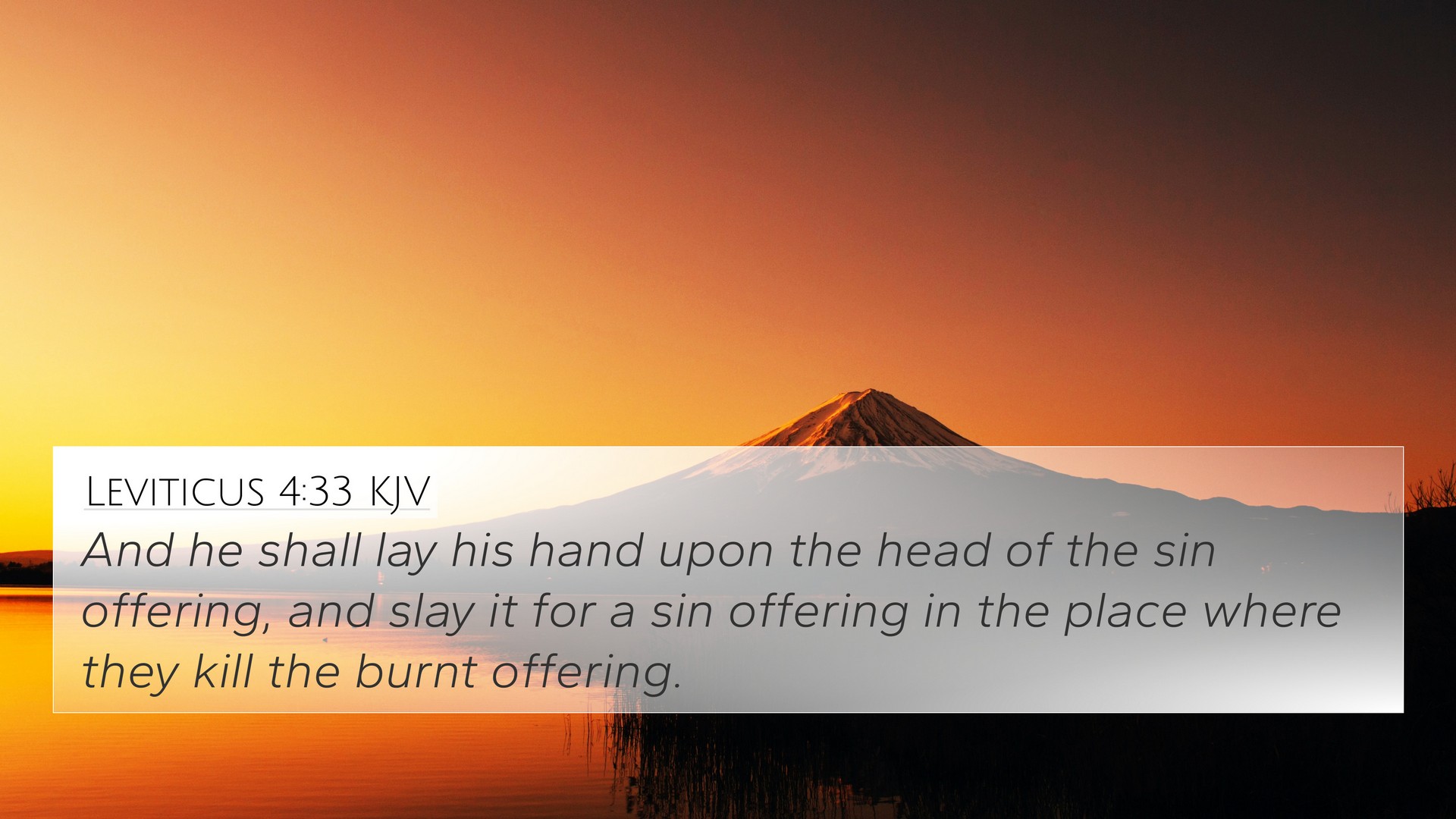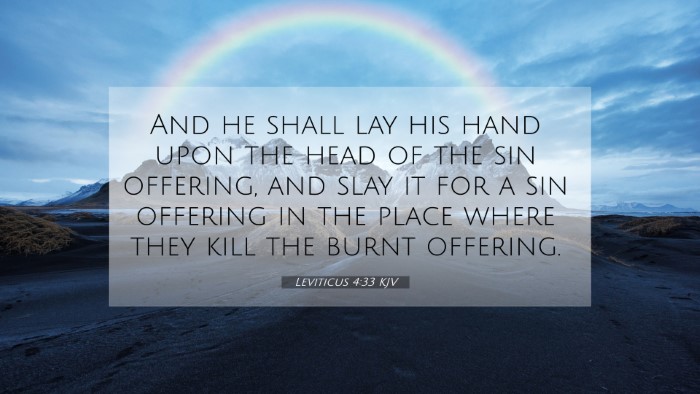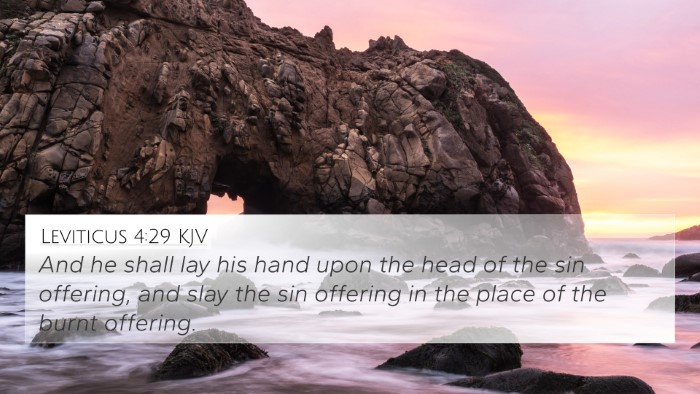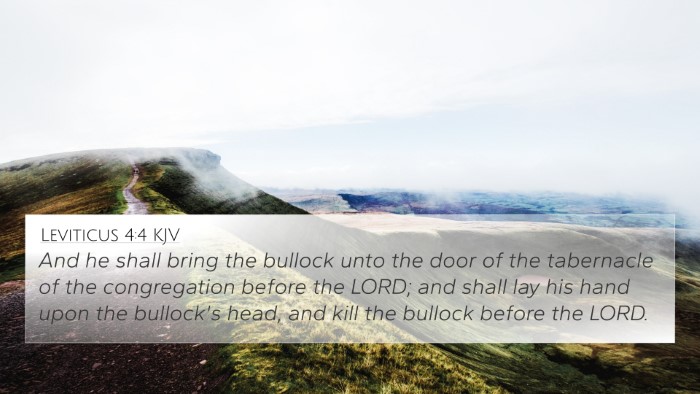Understanding Leviticus 4:33
Leviticus 4:33 states: "And he shall lay his hand upon the head of the sin offering, and slay it for a sin offering in the place where they kill the burnt offering." This verse is part of the detailed instructions provided in the Levitical Law regarding the procedures for sin offerings.
Context and Significance
The book of Leviticus addresses the holiness of God and the means of approaching Him. The sacrificial system was given to the Israelites to atone for their sins and maintain a right relationship with God. Sin offerings were essential in acknowledging wrongdoings and reconciling the individual with the sacred community.
Commentary Insights
-
Matthew Henry:
Henry emphasizes that the laying of hands on the offering symbolizes the transfer of guilt from the sinner to the sacrifice. This act demonstrates the gravity of sin and the necessity of atonement. It represents how serious one’s wrongdoings are, and the need for substitution. The choice of sacrifice must be fitting, indicating the seriousness of sin against a holy God.
-
Albert Barnes:
Barnes points out that the specific regulations regarding the sin offering reflect God’s desire for purity and the prevention of sacrifice becoming a mere ritual. The act of slaying the animal signifies that death is the consequence of sin, affirming that only through blood sacrifice can forgiveness be obtained.
-
Adam Clarke:
Clarke discusses the theological implications of the sin offering in relation to Jesus' ultimate sacrifice. He connects the practice described in Leviticus with New Testament teachings on redemption. Clarke highlights the importance of understanding that the animal sacrifices were types of Christ, foreshadowing His atoning death.
Cross-References for Leviticus 4:33
- Hebrews 9:22: "And almost all things are by the law purged with blood; and without shedding of blood is no remission." This verse emphasizes the necessity of blood for atonement.
- Isaiah 53:6: "All we like sheep have gone astray; we have turned every one to his own way; and the LORD hath laid on him the iniquity of us all." This highlights the transfer of sin which parallels laying hands on the sacrifice.
- 1 Peter 2:24: "Who his own self bare our sins in his own body on the tree, that we, being dead to sins, should live unto righteousness." This connects the sin offering to the ultimate sacrifice of Christ.
- Romans 6:23: "For the wages of sin is death; but the gift of God is eternal life through Jesus Christ our Lord." This teaches about the death that sin incurs, just as the offered animal dies.
- Leviticus 1:5: "And he shall kill the bullock before the LORD: and the priests, Aaron's sons, shall bring the blood, and sprinkle the blood round about upon the altar that is by the door of the tabernacle of the congregation." This reinforces the practice of offering for sin.
- Exodus 29:10: "And thou shalt cause a bullock to be brought before the tabernacle of the congregation: and Aaron and his sons shall put their hands upon the head of the bullock." This illustrates the ceremonial act of transferring guilt.
- Galatians 3:13: "Christ hath redeemed us from the curse of the law, being made a curse for us." This connects to the concept of substitutionary atonement present in Leviticus.
- Matthew 26:28: "For this is my blood of the new testament, which is shed for many for the remission of sins." This New Testament scripture aligns with Levitical sacrifices by highlighting the blood shed for forgiveness.
- Hebrews 10:4: "For it is not possible that the blood of bulls and of goats should take away sins." This underscores the temporary nature of the sacrifices made in Leviticus, pointing to the need for Christ's sacrifice.
Thematic Connections
The practice of sin offerings as discussed in Leviticus 4:33 illustrates the broader theme of sacrifice for atonement that is prevalent throughout the Bible. It is essential to understand how these Old Testament practices inform New Testament theology regarding salvation and forgiveness.
Comparative Bible Verse Analysis
When studying Leviticus 4:33, we see practical implications for today’s believer in understanding sin, guilt, and the need for confession and repentance. The underlying principles remain relevant as they showcase God's holiness, justice, and mercy offered through Christ.
Cross-Referencing Biblical Texts
The connection between Leviticus 4:33 and other scriptures provides a robust framework for understanding the nature of God’s forgiveness and the cost associated with sin. The study of these themes reveals a unified narrative across the Scriptures concerning redemption and the relationship between God and humanity.
Tools for Bible Cross-Referencing
Utilizing tools such as a Bible concordance or a Bible cross-reference guide can significantly enhance one’s study of Scripture. These resources help identify the connections between Bible verses, making it easier to perform a comparative Bible verse analysis effectively.
Conclusion
In conclusion, Leviticus 4:33 serves not just as a historical account but as a representation of God's plan for atonement. Its rich connections to both Old and New Testament scriptures provide depth to our understanding of the sacrificial system and its fulfillment in Christ. Engaging with these scriptures through cross-referencing reveals a tapestry of divine truth, weaving together themes of sin, redemption, and the hope we find in Jesus Christ.




